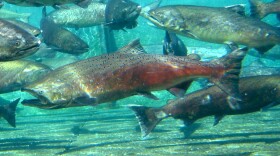-
Nez Perce Tribe install Tesla Megapack for soloar power at wastewater facility.
-
The Upper Columbia United Tribes are working together to prove salmon can be reintroduced – and can survive – in the waters above Grand Coulee.
-
Washington’s salmon are “teetering on the brink of extinction,” according to a new report. It says the state must change how it’s responding to climate change and the growing number of people in Washington.
-
After four years of study, the Record of Decision makes the federal agencies’ preferred option official. Managers and dam supporters say it will benefit salmon, reliable hydropower and the economy. Wild salmon advocates, tribal representatives and renewable energy advocates say this decision will hurt salmon and the orcas that depend on them for food.
-
Water temperatures are expected to increase as the climate warms. Rivers saw a glimpse of what the future could hold five summers ago, when low water flows and hot temperatures killed thousands of salmon.
-
If you want to attend public hearings on the federal government’s plan to manage the Columbia and Snake River dams, you’ll have to do it by phone. The previously scheduled in-person meetings are now teleconferences.
-
The U.S. Army Corps of Engineers, Bureau of Reclamation and Bonneville Power Administration laid out a range of six alternatives in a draft environmental impact statement. The most controversial measure would have been to remove or alter the four Lower Snake River dams.
-
A new energy storage project is in the works near eastern Washington’s Chief Joseph Dam on the Columbia River. The project is expected to bring construction jobs to the region. But the nearby Confederated Tribes of the Colville Reservation worry it would harm important cultural areas.
-
A federal appeals court ruled Friday that the Environmental Protection Agency must do more to protect Columbia basin salmon and steelhead from dangerously warm river temperatures.
-
The U.S. House voted on Monday to pay compensation to the tribe for its losses when Grand Coulee Dam was built in the 1930s and 1940s.
Play Live Radio
Next Up:
0:00
0:00
Available On Air Stations






